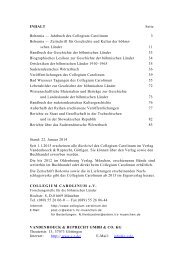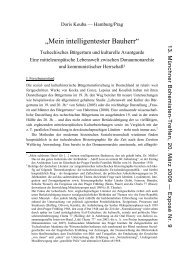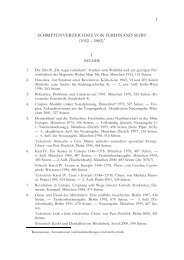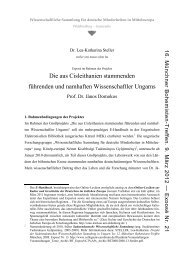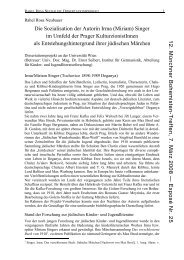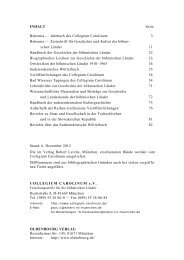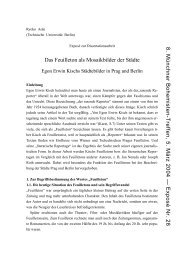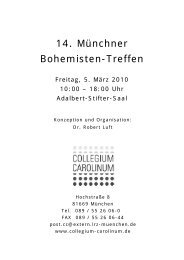Zeitschrift für Geschichte und Kultur der böhmischen Länder A ...
Zeitschrift für Geschichte und Kultur der böhmischen Länder A ...
Zeitschrift für Geschichte und Kultur der böhmischen Länder A ...
Create successful ePaper yourself
Turn your PDF publications into a flip-book with our unique Google optimized e-Paper software.
Bohemia<br />
<strong>Zeitschrift</strong> <strong>für</strong> <strong>Geschichte</strong> <strong>und</strong> <strong>Kultur</strong><br />
<strong>der</strong> <strong>böhmischen</strong> Län<strong>der</strong><br />
A Journal of History and Civilisation<br />
in East Central Europe<br />
Herausgegeben<br />
im Auftrag des Collegium Carolinum<br />
von Martin Schulze Wessel,<br />
Hans Lemberg <strong>und</strong> Michaela Marek<br />
Band 46 Heft 2 2005<br />
AUFSÄTZE<br />
Redaktionsbeirat:<br />
Christoph Boyer (Salzburg), Peter Bugge (Aarhus),<br />
Gary B. Cohen (Minneapolis, MN), Mark Cornwall (Southhampton),<br />
Horst Förster (Tübingen), Steffen Höhne (Weimar),<br />
Miroslav Hroch (Prag), Elena Mannová (Bratislava),<br />
Sheilagh Ogilvie (Cambridge), Jiří Pešek (Prag)<br />
<strong>und</strong> Helmut Slapnicka (Linz)<br />
INHALT<br />
THE CZECHOSLOVAK LAND REFORM OF 1919:<br />
REORGANISING SOCIETY AS THE FOUNDATION ON WHICH THE<br />
REPUBLIC IS BUILT<br />
Joachim von Puttkamer
The 1919 land reform was meant to be a central project of the youthful<br />
Czechoslovak Republic with consi<strong>der</strong>able influence on the structure of the political<br />
system. Whereas in the beginning nationality politics played an important part in<br />
the way the reform was advertised, the reforms themselves intially focused on the<br />
central areas with their Czech majority, if only for practical reasons. This opened<br />
possibilities for Germans to contribute to the reforms in a constructive way, but<br />
the German parties deliberately rejected this option in favour of a strictly negative<br />
stance. The claim however that the German population was systematically<br />
discriminated against, which has often been made with reference to complaints<br />
brought before the Nations’ League, even in relatively recent papers, cannot be<br />
substantiated taking a close look at how the land reform was put into practice. That<br />
the land reform has indeed proved detrimental to the relationship between<br />
Germans and Czechs must be attributed to “nation” becoming more and more<br />
dominant in any argument, whether it merited this position or not.<br />
LA REFORME AGRAIRE TCHÉCOSLOVAQUE DE 1919:<br />
LES TRANSFORMATIONS SOCIALES EN TANT QUE FONDEMENT DE<br />
LA RÉPUBLIQUE<br />
Joachim von Puttkamer<br />
La réforme agraire de 1919 était conçue comme un projet central de la jeune<br />
République tchécoslovaque, qui eut de profondes répercussions sur la structure du<br />
système politique. Bien que les aspects politiques des nationalités jouèrent au début<br />
un rôle important dans la propagande de la réforme, les réformateurs se<br />
concentrèrent tout d’abord de manière pragmatique sur les zones principales<br />
d’habitation peuplées en majorité de Tchèques. Cela leur donna une marge de<br />
manœuvre suffisante pour que la population allemande participe de manière<br />
constructive à la réforme. Cependant, cette réforme fut sciemment détournée par<br />
les partis allemands au profit d’une attitude strictement négativiste. Un désavantage<br />
systématique de la population allemande, comme on le suppose jusque de nos jours<br />
dans la littérature la plus récente en se référant aux plaintes de la Société des<br />
Nations, ne se laisse pas prouver à partir de la mise en place de la réforme agraire.<br />
Le fait que la réforme agraire pesa durablement de manière négative dans les<br />
relations tchéco-allemandes, est plutôt à mettre au compte d’un éloignement dans<br />
les manières nationales d’argumenter qui n’ont pas jusque de nos jours<br />
complètement disparu.<br />
ČESKOSLOVENSKÁ POZEMKOVÁ REFORMA Z ROKU 1919: SOCIÁLNÍ<br />
PŘESTAVBA JAKO ZÁKLAD REPUBLIKY
Joachim von Puttkamer<br />
Pozemková reforma z roku 1919 představovala jeden z centrálních projektů mladé<br />
Československé republiky, který měl výrazný strukturně tvorný vliv na politický<br />
systém. I když v propagaci reformy zpočátku hrály významnou roli nacionálně<br />
politické aspekty, koncentrovali reformátoři pragmaticky svou pozornost nejprve<br />
na oblasti vnitrozemí osídlené převážně česky mluvícím obyvatelstvem. Z toho<br />
vyrostl prostor pro konstitutivní německý podíl na reformě, který byl ovšem<br />
německými stranami vědomně zamítnut ve prospěch striktně negativistického<br />
postoje. Systematické znevýhodnění německého obyvatelstva, o kterém se<br />
v návaznosti na stížnosti Společnosti národů zmiňuje i nejnovější literatura, nelze<br />
na základě praxe pozemkové reformy doložit. Že se pozemková reforma stala<br />
dlouhodobou zátěží česko-německého vztahu, je třeba vztáhnout spíše na ne zcela<br />
překonané osamostatnění se nacionálních argumentačních vzorů.<br />
PRAGUE AROUND 1800: JOSEF BERGLER’S DESIGN OF A MAIN<br />
CURTAIN FOR THE PRAGUE THEATRE OF THE ESTATES, A<br />
DOCUMENT OF ITS TIME<br />
Caroline Sternberg<br />
Applying the tools of art history to the design of the main curtain for the Prague<br />
Theatre of the Estates (Ständetheater) as submitted by Josef Bergler in 1804,<br />
reveals a fitting Bohemian example of the great importance of the arts for the<br />
propagation of the ideas of enlightenment. The present contribution proves that<br />
the project reflects political and societal developments taking place in Bohemia<br />
aro<strong>und</strong> 1800. Using an allegorical image code, Bergler’s design seeks to strike a<br />
balance between paying proper homage to the Habsburg dynasty and referring to<br />
the patriotic self-confidence of the Bohemian Kingdom. The design, commissioned<br />
by the Bohemian diet on September 15, 1804 on the occasion of an Imperial visit<br />
to the theatre, may be interpreted as a statement of the way the Bohemian state saw<br />
itself aro<strong>und</strong> 1800.<br />
PRAGUE VERS 1800:<br />
LE DESSIN DE JOSEf BERGLER POUR LE RIDEAU DE SCÈNE<br />
PRINCIPAL DU THÉÂTRE DES ÉTATS DE PRAGUE EN TANT QUE<br />
TÉMOIN DE SON ÉPOQUE
Caroline Sternberg<br />
La recherche faite en histoire de l’art du dessin de Josef Bergler pour le rideau de<br />
scène principal du Théâtre des Etats (Ständetheater) de Prague de 1804 met en<br />
relief au regard de cet exemple tchèque le rôle important que joua l’art dans la<br />
transmission des idées des Lumières en Bohême. La recherche a ainsi mis en<br />
évidence que les changements politiques et sociaux qui eurent lieu en Bohème<br />
autour de l’an 1800 sont contenus dans les œuvres de cette époque. En s’appuyant<br />
sur des images allégoriques, le dessin de Bergler penche entre l’hommage qui est dû<br />
à la famille impériale des Habsbourg et la référence à la conscience patriotique<br />
nationale du royaume de Bohème. Commandée par les députés des pays bohèmes à<br />
l’occasion de la visite de l’empereur au théâtre le 15 septembre 1804, la<br />
composition du rideau peut être interprétée comme une attestation de l’état d’esprit<br />
dans lequel se trouvait l’Etat de Bohème autour de l’an 1800.<br />
PRAHA KOLEM ROKU 1800:<br />
NÁVRH HLAVNÍ OPONY PRAŽSKÉHO STAVOVSKÉHO DIVADLA OD<br />
JOSEFA BERGLERA JAKO SVĚDECTVÍ SVÉ DOBY<br />
Caroline Sternberg<br />
Uměleckohistorický průzkum návrhu Josefa Berglera na hlavní oponu pražského<br />
Stavovského divadla (Ständetheater) z roku 1804 ukazuje na českém příkladu velký<br />
význam umění pro zprostředkování osvícenských myšlenek. Přitom je dílostředně<br />
doložen politický a společenský vývoj v Čechách v období kolem roku 1800.<br />
Berglerův návrh balancuje na základě alegorického obrazového jazyka na pomezí<br />
mezi patřičnou oslavou habsburského císařského domu a vztahem k zemskopatriotickému<br />
sebevědomí českého království. Vzhledem k okolnostem svého<br />
vzniku, zakázka zadaná českou zemskou reprezentací u příležitosti císařské<br />
návštěvy divadla 15. září 1804, může být kompozice opony chápána jako<br />
manifestace českého státního cítění v době kolem roku 1800.<br />
SUB-PEASANT STRATA IN RURAL SOCIETIES<br />
OF LATE MEDIEVAL EAST CENTRAL EUROPE<br />
Markus Cerman
Scholarly publications dealing with non-peasant landless strata or those having<br />
small, insufficient plots at their disposal still convey, in a rather generalizing<br />
fashion, a picture of the rural scene in late medieval East Central Europe largely<br />
dominated by middle and large farms. To what extent this scene was socially<br />
differentiated is often overlooked, and the role played by sub-peasant strata in<br />
certain regions frequently neglected. The present contribution examines landless<br />
non-peasant strata and those with insufficient plots in three ways: First, their true<br />
share of the population is discussed. In the second place, the variety of sub-peasant<br />
social strata with regard to their legal status, economic situation, and the size of<br />
what plots they had is revealed. Finally, the author devotes his attention to the<br />
problem of distinguishing between peasant and sub-peasant households, which has<br />
frequently been discussed, and to the economic and social links between both<br />
groups. Summing up, one may conclude that the general assumption of a farreaching<br />
dominance of households with plots big enough as to be referred to as<br />
peasant can no longer be maintained and that one has to differentiate along<br />
regional or even local lines even when referring to late medieval East Central<br />
Europe.<br />
LES COUCHES SOUS-PAYSANNES DANS LES SOCIÉTÉS RURALES DE<br />
L’EUROPE CENTRALE DE L’EST AU BAS MOYEN ÂGE<br />
Markus Cerman<br />
Tout comme auparavant dans la littérature de recherche sur les couches de la<br />
population non-paysanne ayant peu ou pas de terre, l’image d’une dominance<br />
relative d’unités économiques paysannes moyennes et grandes est caractérisée de<br />
manière générale dans la société rurale de l’Europe centrale de l’Est au bas Moyen<br />
Âge. Leur différentiation sociale et la grande importance régionale des couches<br />
sous-paysannes ne sont pas appréciées à leur juste valeur. Dans l’essai suivant, les<br />
couches sociales non-paysannes pauvres ayant peu ou pas de terre sont analysées en<br />
trois temps: d’abord, l’auteur considère leur répartition pour présenter dans un<br />
deuxième temps la grande variété des groupes sociaux sous-paysans en tenant<br />
compte de leur position juridique, de leur situation économique et de leurs biens<br />
fonciers. Dans la <strong>der</strong>nière partie, on entre plus en détails dans un problème sans<br />
cesse récurrent dans la littérature – à savoir celui de faire la différence entre les<br />
ménages paysans et sous-paysans – et dans l’analyse des liens économiques et<br />
sociaux entre les deux groupes. L’auteur en arrive à la conclusion que la thèse, selon<br />
laquelle les ménages possédant des biens fonciers auraient largement dominé, ne<br />
tient pas le cap et qu’elle doit aussi faire l’objet d’une différentiation régionale et<br />
locale pour l’Europe centrale de l’Est du bas Moyen Âge.
NESELSKÉ VRSTVY VE VENKOVSKÝCH SPOLEČNOSTECH POZDNĚ<br />
STŘEDOVĚKÉ STŘEDOVÝCHODNÍ EVROPY<br />
Markus Cerman<br />
Odborné literatuře zabývající se neselskými vrstvami venkovské společnosti s<br />
malým či žádným pozemkovým majetkem stále ještě dominuje generalizující obraz<br />
relativní převahy středních a velkých selských hospodářských jednotek ve<br />
venkovské společnosti pozdně středověké středovýchodní Evropy. Sociální<br />
diferenciace a velký význam neselských vrstev v některých regionech nejsou<br />
dostatečně zhodnoceny. V předloženém článku jsou neselské sociální vrstvy s<br />
malým či žádným pozemkovým majetkem podrobeny třístupňové analýze: autor<br />
nejprve věnuje pozornost jejich rozšíření, aby pak následně prezentoval<br />
mnohotvárnost neselských sociálních skupin s ohledem na jejich právní postavení,<br />
hospodářskou situaci a pozemkový majetek. V poslední části se zabývá problémem,<br />
který je v odborné literatuře stále znovu diskutován, a totiž odlišením neselských a<br />
selských domácností od sebe a dále pak hospodářskými a sociálními vztahy mezi<br />
oběma skupinami. Za přínos studie lze označit zpochybnění hypotézy o výrazné<br />
převaze domácností s rolnickým pozemkovým majetkem a zdůraznění faktu, že i<br />
pro poměry pozdně středověké východní Evropy je třeba volit regionálně a lokálně<br />
diferencovaný pohled.<br />
VILLAGE COMMUNITY AND VILLAGE HEADMAN IN EARLY<br />
MODERN BOHEMIA<br />
Sheilagh Ogilvie<br />
What role did the village community play <strong>und</strong>er the “second serfdom”? Did<br />
powerful overlords stifle communal independence, as traditional “manorial<br />
dominance” theories assume? Or were village powers largely untouched, as claimed<br />
by recent “communal autonomy” approaches? This article addresses these<br />
questions by focusing on the pivotal figure of the village headman (German<br />
Scholtz, Schultheiß, or Richter; Czech rychtář). Analyzing a large, micro-level<br />
database for the north Bohemian estate of Friedland/Frýdlant (c. 1580-c. 1740), it<br />
examines how village headmen operated in everyday life – how they were<br />
appointed, what economic privileges they enjoyed, how their village courts worked,<br />
what powers they exercised outside their courts, and which social strata they were<br />
affiliated with. The second serfdom, it finds, was based on neither “manorial<br />
dominance” nor “communal autonomy,” but rather on communal-manorial
“dualism” – close collaboration between manor and commune, huge privileges for<br />
village headmen and communal elites, and few safeguards for weaker villagers such<br />
as women, migrants, and the lower social strata. Strong communes were complicit<br />
with strong overlords in administering and sustaining the second serfdom.<br />
COMMUNAUTÉ VILLAGEOISE ET CHEF DE VILLAGE EN BOHÈME<br />
AU DÉBUT DES TEMPS MODERNES<br />
Sheilagh Ogilvie<br />
Quel rôle jouait la communauté villageoise dans le „deuxième servage“? Est-ce que<br />
les puissants seigneurs réprimaient l’indépendance villageoise comme les théories<br />
traditionnelles de la „dominance manoriale“ le supposent? Ou est-ce que la<br />
répartition des pouvoirs dans le village resta inchangée, comme le clament de<br />
récentes thèses de l’„autonomie communale“? L’essai suivant se consacre à ces<br />
questions en se concentrant sur le personnage central du chef du village (en<br />
allemand: Scholtze, Schultheiß, Richter, en tchèque: rychtář). En analysant une large<br />
base de données au niveau micro de la seigneurie de Friedland/Frýdlant (environ<br />
en 1580-1740) en Bohème du Nord, l’auteur étudie comment les chefs de village<br />
procédaient dans la vie de tous les jours – comment ils étaient nommés, de quels<br />
privilèges économiques ils jouissaient, comment leurs cours de justice<br />
fonctionnaient, les pouvoirs qu’ils exerçaient en dehors de leurs cours et avec<br />
quelles couches sociales ils étaient en relation. Il en arrive à la conclusion que le<br />
„deuxième servage“ n’était basé ni sur la „dominance manoriale“ ni sur<br />
l’„autonomie communale“, mais sur quelque chose que l’on pourrait appeler le<br />
„dualisme“ de la communauté et de la seigneurie – une collaboration étroite entre<br />
le seigneur et la communauté villageoise, les privilèges énormes des chefs de village<br />
et des élites villageoises, peu de systèmes de protection pour les membres les plus<br />
faibles de la communauté tels que les femmes, les migrants et les couches sociales<br />
inférieures. Les communautés fortes travaillaient main dans la main avec les<br />
puissants seigneurs pour administrer et soutenir le „deuxième servage“.<br />
VESNICKÉ SPOLEČENSTVÍ A VESNICKÝ RYCHTÁŘ V RANĚ<br />
NOVOVĚKÝCH ČECHÁCH<br />
Sheilagh Ogilvie<br />
Jakou roli hrála vesnická společnost v „druhém nevolnictví“? Omezovala silná<br />
vrchnost vesnickou samostatnost, jak předpokládá tradiční teorie o „dominanci<br />
vrchnosti“? Nebo zůstalo rozdělení moci ve vesnici nedotčeno, jak postulují novější
teze o „komunální autonomii“? Těmito otázkami se zabývá předložený příspěvek a<br />
v centru zájmu přitom stojí vesnický rychtář (německy Scholtz, Schultheiß,<br />
Richter). Na základě velkého souboru dat z mikroroviny severočeského panství<br />
Frýdlant (cca 1580-1740) je zkoumáno, jak vesničtí rychtáři v každodenním životě<br />
operovali – jak byli pověřováni úřadem, jakých hospodářských privilegií požívali,<br />
jak fungovaly jejich vesnické soudy, jakou mimosoudní moc vykonávali a s jakými<br />
sociálními vrstvami byli spojeni. Autorka dochází k závěru, že „druhé nevolnictví“<br />
nelze chápat ani jako „dominanci vrchnosti“ ani jako „komunální autonomii“, ale<br />
spíše jako něco, co by bylo možné nazvat „dualizmem“ obce a vrchnosti – úzká<br />
spolupráce mezi vrchností a vesnickým společenstvím, enormní privilegia<br />
vesnických rychtářů a vesnických elit, málo sociálních zabezpečovacích<br />
mechanizmů pro slabší členy vesnického společenství: ženy, migranty a spodní<br />
sociální vrstvy. Při uplatňování „druhého nevolnictví“ spolupůsobila silná vesnická<br />
společenství a silná vrchnost.<br />
DISKUSSION<br />
CROSSROADS AND DECISIVE EVENT:<br />
“1956” AND ITS LONGTERM EFFECTS ON EAST CENTRAL EUROPE’S<br />
ECONOMIES AND SOCIETIES<br />
Christoph Boyer<br />
The different and specific ways in which the crises of 1956 were solved in Hungary<br />
and Poland had a decisive longterm effect on the relationship between society and<br />
those in power. Kádárism, having <strong>und</strong>erstood that another “1956” must be<br />
prevented at all events, adopted the method of mo<strong>der</strong>ately and gradually<br />
liberalizing its economy and society while allowing no doubt that it remained<br />
strictly loyal to the Eastern bloc, supporting this strategy with placing greater<br />
emphasis on consumer goods availability. In Poland, the crisis was brought to a<br />
close below the threshold above which Soviet intervention would have taken place;<br />
opportunities remained for consi<strong>der</strong>ably more intensive struggle between those in<br />
power and the opposition. The solution to the Czechoslovak crisis in 1953 with a<br />
comparatively low lewel of violence and the handling of “June 17” in the GDR,<br />
where intervention was more violent, had basically comparable longterm effects on<br />
the way the relationship between party power and society evolved.<br />
UN TOURNANT HISTORIQUE ET UN ÉVÉNEMENT-CLÉ:<br />
„1956“ ET LES CONSÉQUENCES À LONG TERME SUR LES<br />
ÉCONOMIES ET LES SOCIÉTÉS D’EUROPE CENTRALE DE L’EST
Christoph Boyer<br />
Les „solutions spécifiques“ des crises en Hongrie et en Pologne en 1956 ont régi à<br />
long terme la relation de pouvoir et de société: le Kadarisme, qui avait assimilé les<br />
leçons tirées des „solutions“ et compris qu’il fallait à tout prix éviter un nouveau<br />
„1956“, choisit la voie de la libéralisation modérée et graduelle de l’économie et de<br />
la société basée sur une politique de la consommation – cela tout en restant un pays<br />
ancré inconditionnellement au Bloc de l’Est. En Pologne, la crise fut réglée sous la<br />
menace d’une invasion soviétique; là, la marge de manœuvre pour des discussions<br />
nettement plus âpres entre pouvoir et contre-pouvoir resta ouverte. En 1953, la<br />
solution relativement peu violente à la crise tchécoslovaque et les méthodes plus<br />
violentes utilisées pour mater les insurrections du „17 Juin“ en RDA fondèrent en<br />
principe des dépendances comparables dans les choix à long terme entre les<br />
pouvoirs du parti et la société.<br />
ROZCESTÍ A KLÍČOVÁ UDÁLOST:<br />
“ŠESTAPADESÁTÝ“ A JEHO DLOUHODOBÉ DOPADY NA<br />
HOSPODÁŘSTVÍ A SPOLEČNOSTI STŘEDOVÝCHODNÍ EVROPY<br />
Christoph Boyer<br />
Specifické „řešení“ krizí v Maďarsku a Polsku 1956 určilo dlouhodobě vztah mezi<br />
mocí a společností: pod vlivem snahy zabránit za každou cenu dalšímu<br />
„šestapadesátému“ se kádárizmus vydává na cestu konsumní politikou živené mírné<br />
a postupné liberalizace hospodářství a společnosti – a to při bezpodmínečném<br />
zachování věrnosti bloku. V Polsku skončila krize bez sovětské invaze; zde zůstává<br />
otevřen prostor pro výrazně ostřejší střety mezi mocí a opozicí. Řešení<br />
československé krize 1953 s porovnatelně nižší a ukončení „17. června“ v NDR s<br />
vyšší intenzitou násilí odůvodňují v zásadě srovnatelné dlouhodobé podmínky pro<br />
vývoj ve vztahu mezi stranickou mocí a společností.<br />
MISZELLEN<br />
Das Bier <strong>der</strong> guten Zeiten: Victor Cibich, <strong>der</strong> Mann, <strong>der</strong> dem Bier sein Gesicht gab<br />
(Miroslav Němec)<br />
Die Wahlen von 1946: Illusion <strong>und</strong> Realität (Michal Pehr)
Die kirchliche Topografie <strong>und</strong> das Pfarrnetz <strong>der</strong> Prager Kirchenprovinz im<br />
Spätmittelalter (Pavel Kůrka)<br />
Zwischen den Diktaturen. Kirchen <strong>und</strong> Religion in <strong>der</strong> Tschechoslowakei 1945-<br />
1948 (Laura Hölzlwimmer)<br />
Adelsgeschichte <strong>und</strong> Elitenforschung (Birgit Lange)<br />
Nationale „Schutzvereine“ in Ostmitteleuropa 1870-1950 (Angela Gröber)<br />
Heldentum <strong>und</strong> Feigheit in <strong>der</strong> tschechischen politischen <strong>Kultur</strong> des 19. <strong>und</strong><br />
20. Jahrh<strong>und</strong>erts (Jan Randák)<br />
NEUE LITERATUR<br />
Fejtová, Olga/Ledvinka, Václav/Pešek, Jiří/Vlnas, Vít (Hgg.): Barokní Praha –<br />
Barokní Čechie 1620-1740 (Helena Peřinová)<br />
Schlögel, Karl: Marjampole o<strong>der</strong> Europas Wie<strong>der</strong>kehr aus dem Geist <strong>der</strong> Städte<br />
(Steffen Höhne)<br />
Braun, Helmut (Hg.): Czernowitz. Die <strong>Geschichte</strong> einer untergegangenen<br />
<strong>Kultur</strong>metropole (Steffen Höhne)<br />
Kliems, Alfrun (Hg.): Slowakische <strong>Kultur</strong> <strong>und</strong> Literatur im Selbst- <strong>und</strong><br />
Fremdverständnis. Ludwig Richter zum 70. Geburtstag (Susanne Fritz)<br />
Trpaslík v evropské kultuře (Hans Lemberg)<br />
Hardtwig, Wolfgang (Hg.): Utopie <strong>und</strong> politische Herrschaft im Europa <strong>der</strong><br />
Zwischenkriegszeit (Pavel Kolář)<br />
Fritz, Susanne: Die Entstehung des „Prager Textes“. Prager deutschsprachige<br />
Literatur von 1895 bis 1934 (Peter Becher)<br />
Soukup, Pavel/Šmahel, František (Hgg.): Německá medievistika v českých zemích do<br />
roku 1945 (Jiří Pešek)
Becher, Peter/Fiala-Fürst, Ingeborg (Hgg.): Literatur unter dem Hakenkreuz.<br />
Böhmen <strong>und</strong> Mähren 1938-1945 (Dieter Wilde)<br />
Glassheim, Eagle: Noble Nationalists. The Transformation of the Bohemian<br />
Aristocracy (Jiří Georgiev)<br />
Müller, Uwe (Hg.): Ausgebeutet o<strong>der</strong> alimentiert? Regionale Wirtschaftspolitik <strong>und</strong><br />
nationale Min<strong>der</strong>heiten in Ostmitteleuropa (1867-1939) (Jaromír Balcar)<br />
Schmid, Daniel C.: Dreiecksgeschichten. Die Schweizer Diplomatie, das „Dritte<br />
Reich“ <strong>und</strong> die <strong>böhmischen</strong> Län<strong>der</strong> 1938-1945 (Jörg Osterloh)<br />
Staněk, Tomáš: Poválečné „excesy“ v českých zemích v roce 1945 a jejich<br />
vyšetřování (Piotr M. Majewski)<br />
Knapík, Jiří: Únor a kultura. Sovětizace české kultury 1948-1950 (Stefan Zwicker)<br />
Kift, Dagmar (Hg.): Aufbau West. Neubeginn zwischen Vertreibung <strong>und</strong><br />
Wirtschaftsw<strong>und</strong>er (Karin Pohl)<br />
Hamersky, Heidrun: Gegenansichten. Fotografien zur politischen <strong>und</strong> kulturellen<br />
Opposition in Osteuropa 1956-1989 (Petra Schindler-Wisten)<br />
Blehová, Beata: Der Fall des Kommunismus in <strong>der</strong> Tschechoslowakei (Volker<br />
Strebel)<br />
Růžička, Daniel: Major Zeman – propaganda nebo krimi? (Jiří Knapík)<br />
Havel, Václav: Prosím stručně. Rozhovor s Karlem Hvížďalou, poznámky,<br />
dokumenty (Jiří Kosta)<br />
Linde, Jonas: Doubting Democrats? A Comparative Analysis of Support for<br />
Democracy in Central and Eastern Europe (Elisabeth Bakke)




